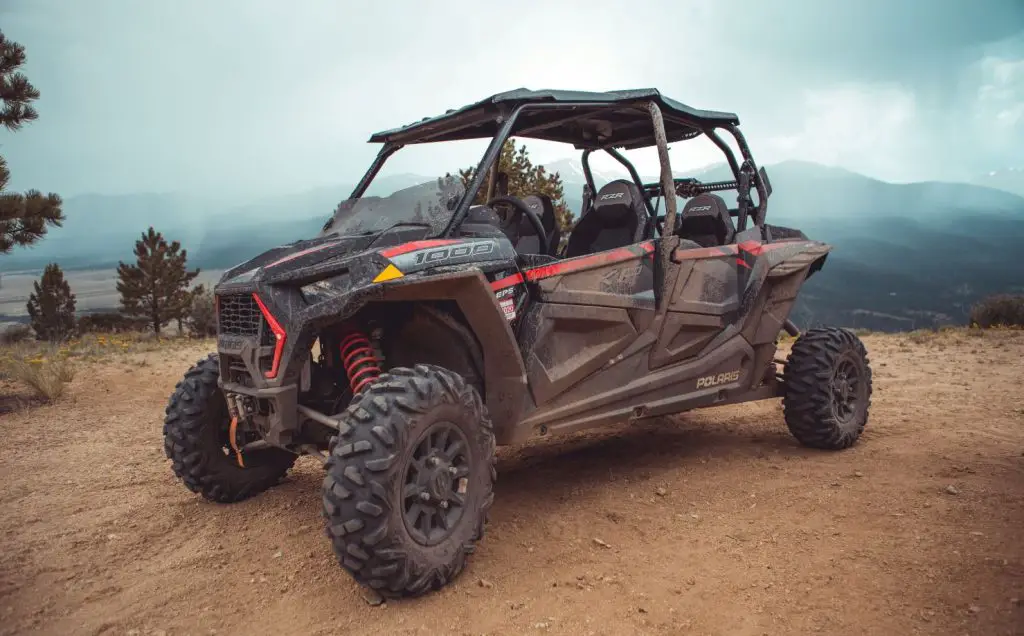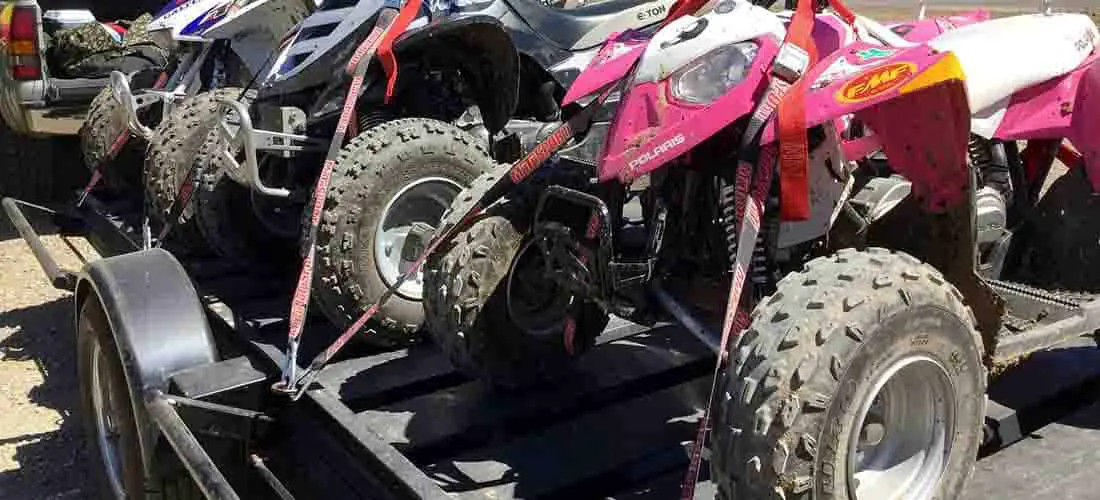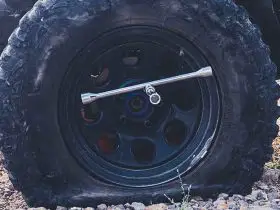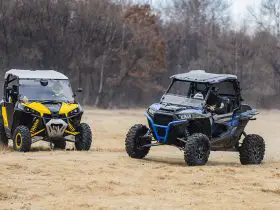The trailer needs to be proper attached to the car before loading the UTV on to the trailer. The cars parking brake should be engaged. Use loading ramps and drive carefully up on the trailer. Make sure to put the straps thru solid places like the frame. Do not put straps around the suspension or drive axels due to the risk of damaging the vehicle.
Different UTV users have different ways of getting their vehicles from one place to another. However, it seems that most of the side-by-sides you see transported on the highways and streets are mounted onto a trailer. Using a trailer for UTV transportation is probably the most convenient and least expensive way of getting your UTV from your home to your riding spot.
But, before you get on the road, UTV needs to be loaded and properly secured. Although this seems like a simple task at first glance, loading your ride has to be handled with utmost attention and care. This is important due to your own safety and, also, for the protection of your investment. While you drive to your desired destination, it’s more than likely that you will face road bumps and unpredicted traffic situations. If your side-by-side is not secured in the right way, it may be seriously damaged. And, as we all know, UTV’s are not exactly the cheapest toys out there.
Table of Contents
Loading a UTV on a Trailer
Selecting the Trailer
Plenty of newer UTV models are too large to be mounted on pickup trucks so the trailer is probably the best solution for their transport. Choosing the right trailer can make all the difference when it comes to the vehicle’s security and the ease of loading. Of course if you don’t need to transport your SxS that often, renting a trailer is also an option.
Take into account the dimensions and weight of your UTV when shopping for a trailer. The weight of the vehicle plays the biggest role when deciding between a single or double axle trailer. Tandem axle designs can handle more weight and are sturdier and stable, but single axle ones are significantly cheaper and can do just fine if you own one of the smaller UTV models. This also plays a part in properly placing a vehicle on the trailer’s surface. Another factor that plays here is that many people travel with more than one UTV or haul an ATV also.
On the other hand, the overall dimensions of your four-wheeler will influence whether you get the enclosed or open trailer. Enclosed models will provide better protection from natural elements and road debris, but you may have some trouble loading and fitting larger vehicles into them.
It’s a good idea to get a trailer with a built-in easy-access ramp gate. There are plenty of available models on the market. This will make the loading easier and you won’t need to drag the loading ramps everywhere you go.
Loading Ramps
If you don’t own a trailer that has one built-in, then you’ll also need to acquire a loading ramp. The main factor to be aware of when deciding on a ramp is your UTV’s weight. Make sure you get a heavy-duty ramp that can fully support the wet weight of the vehicle. Pay attention that the ramp you end up with can be attached to your trailer. Depending on the trailer’s height and width, you can go with a single ramp or a dual runner, If you’re short on storage space, look into one of the foldable models.
Before Loading
Before loading a vehicle, there are a couple of things you need to check on. First of all, make sure you’re on a flat and even surface and keep the vehicle and trailer as level as possible. If one of the tires is not touching the ground, do not load the UTV and find the surface with no grade. The towing vehicle parking brake should be engaged.
Then connect the trailer tongue to a tow vehicle hitch. Hook up safety chains and wires and verify that they are secure and properly connected. Under the tongue, cross the safety chains in an “X” formation. Prior to loading, test electrical connections, and brake harness. this is much easier to do with an empty trailer.
The majority of riders don’t do this when loading up but put on a helmet. You will be driving a short distance at an extremely slow speed, but accidents still can happen and at least you want your head protected. Better safe than sorry.
Driving Up and Placing a UTV on a Trailer
After all the preparation, you’re ready to load up your UTV on a trailer. Line up the wheels of your side-by-side dead straight with the towing vehicle’s center. Place the UTV in the lowest possible gear and activate four-wheel-drive mode if you have it. In this case slow and steady wins the race. You want low speed, but also more torque. This will also prevent the SxS from making sudden jerk movements in case you press the gas too much. Gently apply the gas and creep slowly up the ramp. Try to do this in one continuous movement and avoid stopping and starting. If you feel you’ve pushed the throttle too much, it’s best to back up to the flat ground and start over.
When you crest over the ramp and reach the trailer’s deck, slowly move towards the front and gently brake to stop the UTV. Shut down the engine and put the vehicle in park and engage the parking brake. Depending on your UTVs type of transmission, some UTV users prefer to leave the vehicle in gear, but experience tells that this is a much safer option. Make sure not to forget to remove the key from the ignition.
The placement of the UTV on the deck will depend on the trailer’s design but, in general, the weight should be distributed towards the front side. Parking closer to the rear may cause problems with handling while driving. Apply the “60/40” rule, meaning that roughly 60 percent of the weight should be in the front half.

Securing and Strapping Down a UTV
Once your UTV is on the trailer, you need to secure it and make sure it stays safe in place for the duration of the transport. This can be achieved with several anchoring options. While some still use plain old chains and rope, now there are much more modern and safer options available.
Ratchet Tie-Downs
The most common method of securing the UTV on a trailer is by using ratchet straps to anchor them to the deck. There is a variety of straps available on the market, ranging in price and quality. This is not where you should prefer budget options and think about saving money. Find quality straps that can withstand the weight of your side-by-side that are durable and can resist weather conditions.
Although some people are using two straps to tie down their vehicle, the safer and recommended option is using four. One at the driver’s side in the front and one at the rear. The same goes for the passenger’s side. You need to identify the best tie-down attachment points on your UTV. The best points are at the frame of your vehicle because it’s the hardest and sturdiest part of the UTV. You can also use the front bumper if its firmly welded to the frame or the hitch for back straps. Always try to look for the lowest possible points of attachment. Straps should be set at an angle sharper than 45 degrees. Avoid strapping to the suspension or axles because it can cause damage to your vehicle. Also, check if strap goes over any sharp edges because in time it will wear down and break.
After you’ve attached straps to the vehicle, you need to anchor them to the deck. Once the strap is hooked up to the frame, roll out the other end to a tie-down spot on the trailer and tighten it using the ratchet. Do this for all four straps. You should anchor the straps to the furthermore points on the trailer. When you finish, inspect the straps to see if they are properly tightened.
Using this method compresses the suspension to some point. The lower attachment points on the vehicle are, the suspension will be less compressed and it will allow your UTV to bounce a little bit. Although the compressed suspension is not necessarily a bad thing. After all, the manufacturers themselves ship the vehicles this way.
Tire Bonnets
Another popular method is using tire bonnets or wheel baskets. These are specifically arranged straps that go over each wheel creating sort of a basket for the tire. They are secured to the deck behind the wheel. The downside of this method is that bonnets must have tie-down points directly behind and in front of the wheels. Although very safe, this system needs to be very precise and can be somewhat complicated and time-consuming. Also not every trailer is compatible with this anchoring approach.
Wheel Chock
You can also use a wheel chock to hold your UTV in place. It’s the system that employs plates that you bolt down to your deck and use to align tires between them and then strap the wheels with webbing wraps. The metal brackets on each wheel prevent them from moving. These straps are usually adjustable and can be used on a number of types and sizes of tires. Some UTV owners use more traditional chocks without the straps.









